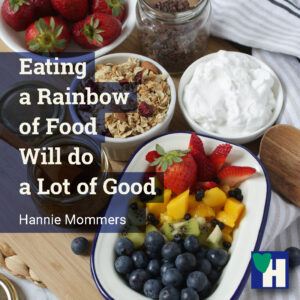
Eating a rainbow of food is healthy. To always eat the same food is not good. Every day, we try to balance the composition of the colors of what we eat.
This may sound a little bit strange, but we do this because different fruits and vegetables have different qualities. Mixing the colors helps you to optimize the balance of all the different nutrients, vitamins, and minerals you need.
Each nutrient in fruits and vegetables has its significant impact on our health. This is even more significant when we encounter minor health problems. Get as much color variety in your diet as you can. Eating a rainbow of food will do a lot of good.
Some of the links are affiliate links. As an affiliate associate, we earn a commission when you purchase any of the products offered through the shared links at no extra cost for you. This helps us maintain this website.
Table of contents
Fruits and vegetables of all colors

The colors of the fruits and vegetables we eat offer a small clue to the nutrients, vitamins, and minerals we need. During the past months, we have posted six articles explaining the different advantages of specific colored fruits and vegetables.
In this article, we summarize the results. One by one we introduce the most significant qualities of the different colored fruits and vegetables. The links to the separate articles are down below.
This is important because there you will find lots of excellent recipes and cooking tips that illustrate how we practice what we preach: Eating a rainbow of food will do a lot of good.
Orange food
To eat with appetite is as important as eating the right amount of nutrients, vitamins, and minerals. Orange food strengthens, calms, and promotes our appetite. Orange food also strengthens our eyes.
And it protects our skin against air pollution and the dangerous ultraviolet rays of the sun. Pumpkins and carrots are examples of healthy and tasty orange food. The benefits of pumpkins as a tasty and healthy food are numerous:
- Pumpkins make us feel fit, as well from the ‘meat’ of the pumpkin as from its seeds;
- The potassium in pumpkins lowers our blood pressure and ensures a good recovery after a workout;
- They are perfect for weight control because pumpkins contain lots of fibers and are short on calories;
- Pumpkins make your skin supple and healthy;
- They also reinforce our immune system and eyesight;
- As a superfood, pumpkins are considered a mood booster.
Red food
The most obvious health benefits of red food result from antioxidants. Especially when we get older it’s important to look carefully at what we eat. We emphasize variety. The health benefits of antioxidants also get extra attention.
Antioxidants are a complex physical compound. They control the free radicals that can damage our cells. In their turn, free radicals are important for all kinds of chemical processes that keep the body going.
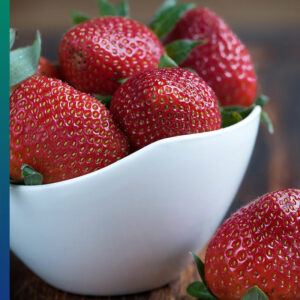
Our health is in good condition when antioxidants and free radicals are in balance. Although food is an important source of antioxidants, too many antioxidants can have a reverse effect when we age.
Famous red fruits are the – always very tasty – strawberries. We grow them in our garden for 8 months of the year. Delicious.
Yellow food
Yellow food has two big benefits: it’s a mood booster and it’s very beneficial to your skin. Like its color, it’s sunny, glowing, and radiant. Yellow fruits and vegetables contain phytochemicals, antioxidants, vitamins, and minerals that can combat severe illnesses and heart issues.
One of the phytochemicals in yellow fruits and vegetables is called bioflavonoid. This is sometimes referred to as Vitamin P. This element is especially helpful for the skin to replenish itself.
Mango and pineapple are fine and very tasty examples of yellow fruits. And corn and yellow bell pepper are examples of yellow vegetables.
White food
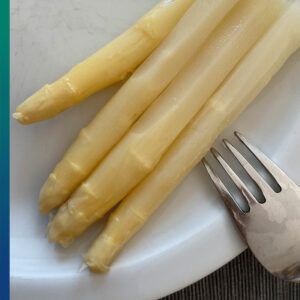
A high intake of white food may reduce the risk of a stroke by 55%. In a healthy and nutritious diet, white fleshy fruits and vegetables are common.
Apples and bananas are very popular white fruits. Cauliflower and asparagus are well-known white vegetables.
Examples of nutrients in white fruits and vegetables are beta-glucans in cereals, catechin (EGCG) in peaches and vinegar, thiamine, magnesium, potassium and phosphorus in flax, sunflower, sesame and pumpkin seeds, and lignans.
Dietitians claim that these nutrients boost immune activity, activate ‘natural killers’ B and T cells (important in the prevention of cancers), reduce the risk of colon, breast, and prostate cancers, and reduce the risk of hormone-related cancers through balancing hormone levels.
Green food
Do you remember Popeye the Sailorman? I always thought the comic movies featuring Popeye were a trick from grown-ups to get children to eat more vegetables. As a kid, I never thought that there was actually truth to the benefits of spinach.
Broccoli has somewhat taken over the role of spinach. Many children dislike broccoli as much as we disliked spinach. Fortunately, for most of them, it’s only a phase in life.
Green food has a lot of chlorophyll, which is beneficial for the plant itself. Chlorophyll is vital for photosynthesis, which allows plants to absorb energy from the sunlight and thus produce nutrients.
For us, chlorophyll is wondrous as well. Chlorophyll is rich in magnesium. Magnesium is essential to all cells of the human body. Moreover, 300 of our enzymes require magnesium ions to function. Enzymes are the biological catalysts that accelerate more than 5,000 essential chemical reactions in our bodies.
The health benefits of green fruits and vegetables:
- Improves blood circulation and purifies your blood – which makes it great in fighting acne;
- Strengthens the immune system;
- Is good for the intestinal flora – it lessens bad breath;
- Gives a lot of energy;
- Works preventive against cancer;
- Dissolves mucus, particularly in the lungs;
- Makes you clear-headed and works well against depression;
- Improves the functioning of the liver, gallbladder, and kidneys;
- Is low in calories – helps to lose weight.
Blue and purple food
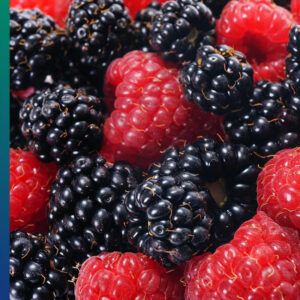
Blueberries, blackberries, blackcurrants, red grapes, and plums are stuffed with natural blue-purple pigments, known as anthocyanins. Foods with a high anthocyanin content are assumed to promote heart health and reduce our risk of overweight, type 2 diabetes, certain cancers, and other diseases.
Purple fruits should be as ripe and dark as possible for a maximum amount and effect of the anthocyanins. Research shows that anthocyanins have a positive effect on weight management by increasing metabolism and regulating blood sugar levels. Anthocyanins are also suspected of having a beneficial effect on our brain and memory.
Dark fruits and vegetables are also rich in vitamin K. Which is good for your bone structure. Scientists say a lack of vitamin K may contribute to osteoporosis, a condition in which your bones become weak and fragile.
Blueberries are said to benefit our brain immensely, making me include them in my breakfast almost every day now. And elderberries strengthen your immune system thus helping you defend yourself against a cold and flu. It helps people to recover faster from these diseases.
Eating a rainbow of food
Our rainbow of food also includes a large variety of nuts (including chestnuts and coconuts), figs and dates, seeds, herbs, and mushrooms.
Related: How Healthy are Mushrooms? 7 Reasons to eat them.
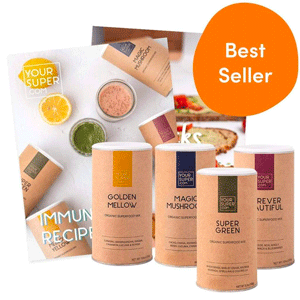
Use our code OURGREENHEALTH at checkout for an additional 15% reduction on your whole order.
Herbs do not only spice our foods, they are also good in teas (mint tea is one of my favorites). Moreover, many herbs have medicinal qualities. In modern medicine, around a quarter of the drugs prescribed are derived from medicinal herbs.
The majority of human calories come from edible seeds. Of course, cereals are best known as a nutrient. Seeds of pumpkins and sunflowers are also very popular. Lightly roasted sesame seeds are very tasty.
A nut is also a seed, in fact, it’s a fruit composed of a hard shell with a seed inside. Like almonds or chestnuts. Their shell is hard and the fruits inside are soft and edible. In dates, it’s the other way around. The seeds are hard and the shell is soft and edible.
Related: Best Seeds to Eat for your Daily Dose of Healthy Supplements
Health benefits of food
Scientists do not always agree on the effects of food on our health. There are probably as many specialists that argue cranberry juice helps with bladder problems as others who say it doesn’t.
It’s the task of scientists to cast doubts on the truth, any truth. That’s what makes their job so important and interesting. This is why the methods they use make us a big advocate of testing food ourselves. Moreover, there is no ‘one size fits all’ approach. It’s very important we listen to our bodies.
Let’s not forget, eating a rainbow of food will do a lot of good.

Enjoy your meal and stay healthy!
Do you have a favorite recipe you want to share? Put it in the comment box below.
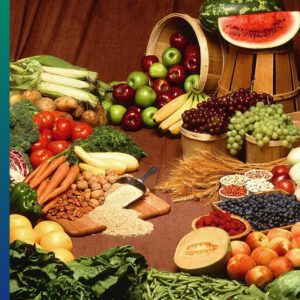
Rainbow food
- Eating a Rainbow of Food Will do a Lot of Good
- Red Food and the Health Benefits of Antioxidants
- What Are the 3 Best Orange Foods we Should Eat Regularly?
- Yellow Foods that Boost your Immune System Naturally
- How to Improve your Diet – and Health – with White Fruits and Vegetables
- Is Spinach the Best Green Vegetable to Eat Every Day?
- Healthy Food Dishes with Blue and Purple Fruits and Vegetables

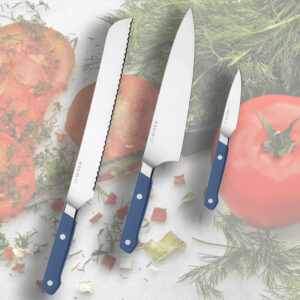
Hi Hannie,
I am sometimes guilty of always eating the same food, but lately I have started buying different foods, to have some variety. I hardly buy pumpkin, because I find it hard to cut it up, and a little time consuming 😉 but I will start adding it more often to my diet. It’s also good for dogs (I cook for them).
Are cranberries considered purple food? I am growing some cranberry trees on my land, they’re not that big yet, but they are growing well. I am also growing pineapple plants. Did you know that it takes 2 years for a pineapple plant to grow its first fruit …? I guess I better buy it in the store in the meantime, haha. Nevertheless, a homegrown pineapple tastes so much better than the storebought version. The first one that grew here was so incredibly sweet and delicious.
Exactly, Christine, I agree with you that what’s grown on our own land or garden tastes so much better than the supermarket stuff. Although it’s been a long time since I ate supermarket produce. What we buy in the organic stores comes mainly from the local farmers and tastes very good as well.
It’s also the idea of the amount of work that went into it, don’t you think? The satisfaction adds to the taste, I guess. 🙂
Cranberries are more red than purple, aren’t they? But it doesn’t matter that much. Red or purple, they are super healthy. Especially for women. It helps against urinary infections. Unfortunately, I can hardly find any here. It seems Cranberries are more a Northern European berry. It must be terrific to have them in your own garden. As well as the pineapples! I envy you for having so much space 😉
I think that the key to healthy living is always to mix all kinds of foods. However, I think that people mostly (at least I do) eat few kinds of food all the time. That’s a big mistake, and sometimes it’s hard to fix it.
Almost every day, we’re in a rush, and I think that the last thing on our mind is the food, and it should be high on the list.
How do you make sure to eat different foods throughout the week? Do you sometimes prepare meals beforehand? Whenever I’m in a rush, I pick whatever is the first in the fridge, and I want to change that.
Eating all kinds of foods already start at the store, Petar. As you know Tom has written a great article about that: Food with a Conscience is More than just Healthy Food. If you choose all colors when you are in the vegetable department, you will have plenty to choose from when you are standing in front of your fridge. 😉
Yet, you are right, it’s hard to change habits. Whether they are good habits or bad ones, it is really difficult to modify them. There are tricks for, of course. For instance, what I do is making a list of the habits I want to change and tick them off at the end of the day if I have done it right that day.
You can say you’re too busy for that as well, but then again, wouldn’t that be the first habit you can better change? If you want to age healthily you will have to work on yourself to develop healthy habits.
Yes, at times we prepare food in a bigger quantity than we would eat that day and freeze what is left. Another thing you can do is eat things raw. Little carrots are great to nibble at when you’re hungry and in a rush. So are nuts, raisins, dates. All are healthy and require no preparation time.
Thanks for asking and good luck with your change. 🙂
I love the rich natural colors of fruits and vegetables.
I grew up in New Zealand many years ago and in the ’70s the food choices were limited compared to what is available today. This is because NZ is so far away from the rest of the world that importing fresh produce was too expensive and impractical. Technology and rapid shipping have changed all of that.
However, now I live in SE Asia and I absolutely love the huge variety of fruits and vegetables that we never had at home. It’s just awesome to go to the local markets when I am traveling around and see something new…. and then to taste it! Most of the time I enjoy the experience, and even when the taste is not agreeable with me, it’s still exciting to try new foods.
I’m with you 100% when you say that we need to eat from the whole rainbow to ensure that our bodies get all of the nutrients and minerals they need to function optimally.
Many thanks for sharing 🙂
Hi Andrew,
Thank you for your comment.
You’re right, in the Seventies food choices were limited. There weren’t even that many supermarkets. How the world changed.
Today we can buy any type of food in any of the numerous supermarkets any time of the year. Yet, we limit our choice to organic fruits and vegetables.
We buy this in specialized shops and not in the supermarket. Although more and more supermarkets have a small assortment of organic food. However, most of it is processed and we prefer fresh produce.
This limits our choice of fruits and vegetables to the season and to the local organic farmers. Fortunately, we have a variety of those close by.
We’ve never been to SE Asia. I have no idea what type of foods to expect there. But given your explanation, it must be exciting. I hope the fruits and vegetables there also come in all kinds of colors.
For now, stay safe, stay healthy.
Regards,
Tom
Hi Hannie, I am getting hungry reading this article. 😉
I love vegetables and fruits so much that there must be always berries or mangos on my salad. They are very healthy and delicious.
I am jealous that you can 8 months harvest strawberries. But of course, you have so much sun. They are so tasty, and we use them also on cooked meals.
I think I am pretty good at eating all the rainbow colors; I often blend or juice them. But eating a salad with some organic meat or grilled fish is sooooo tasty. I am getting the vegetables and fruit, like apples and pears, on the farmer’s market. But exotic fruit I am buying in the Turkish supermarket, like mango and pineapple.
Dates and raisins are great for breakfast, with some seeds. I love sesame also roasted lightly, and sesame oil that has a great taste. You have learned to prepare Mediterranean meals; I read your recipes. For sure, I will try it, Hannie, and let you know.
Hi Sylvia,
Thank you for your comment. And you’re a real rainbow food fan. Which is also great.
However, I’m sorry to inform you that it’s not Hannie who has learned to prepare Mediterranean meals. Although lately she is trying to pick up cooking once a week on a sunday.
I like to experiment with cooking, and the Mediterranean style is one of them. Fortunately, Mediterranean is so enormously varied. Italian food is different from Greek, Egyptian food is different from Maroccan, and even the Spanish and Portugese kitchens differ. So it’s great fun for me to try them all.
For me cooking is a serious business. Not just because it’s important to eat tasty food, but also because it’s of great influence on your mood and health. This means that preparing meals always takes a lot of time. Since I love cooking, this is no problem for me. It’s also a meditative act for me.
Of late, I also started to prepare Indian recipes. What I like about many of them that you have to marinate food which forces you to think and work ahead. Usually 24 hours. Normally, I watch what’s in the freeze or in the garden and start preparing.
We now have a lot of broad beans, and carrots, and spinach in the garden. The carrots are not that big and the spinach is not that much, so I use these in the smoothies Hannie eats. Once a week we have a meal with broad beans. Tomorrow already for the third time this month.
It’s nice to combine cooking and growing your own herbs, fruits and vegetables. This also makes me modest, because each time I get some food out of our garden, I realize how few we can grow ourselves. Our garden is just too small.
Although Hannie does hardly prepares our meals, she undoubtedly will be very curious how you will experience you’re Mediterranean style cooking. And also am I. Please let us know.
For now, stay safe, stay healthy.
Regards,
Tom